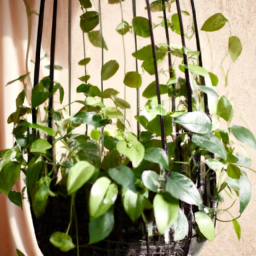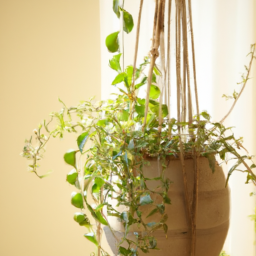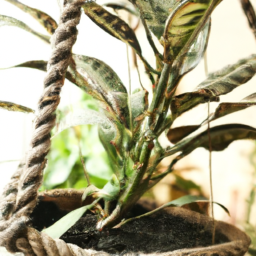
Are you looking to add some greenery to your indoor space? Hanging plants are a great way to bring the beauty of nature indoors while saving valuable floor space. In this blog post, we will explore the different types of hanging plants that thrive indoors, perfect for adding a touch of green to any room. Whether you have a sunny spot by a window or a shady corner that needs some life, there is a hanging plant out there for you. So let’s dive in and discover the wonderful world of types of hanging plants indoor.
Types of Hanging Plants Ideal for Indoor Spaces
Welcome to our guide on the best types of hanging plants for indoor spaces! Hanging plants are a great way to add a touch of greenery to your home, without taking up valuable floor space. In this article, we will explore some of the most popular and easy-to-care-for hanging plants that are perfect for indoor environments.
1. Spider Plant
The Spider Plant, also known as Chlorophytum comosum, is a classic choice for hanging plant enthusiasts. This plant is incredibly easy to care for and is known for its air-purifying qualities. The Spider Plant features long, thin leaves that arch gracefully from the center of the plant, creating a cascading effect when hung from a ceiling or wall hook.
To care for your Spider Plant, place it in indirect sunlight and water it regularly, allowing the soil to dry out between waterings. Spider Plants are also known for producing small white flowers, adding an extra touch of beauty to your indoor space.
In addition to its aesthetic appeal, the Spider Plant is also safe for pets, making it an ideal choice for pet owners looking to add some greenery to their home.
2. Pothos
Pothos, also known as Epipremnum aureum, is another popular choice for indoor hanging plants. This plant is incredibly versatile and can thrive in a variety of lighting conditions, making it perfect for homes with limited natural light.
Pothos features heart-shaped leaves that come in a range of colors, from deep green to variegated shades of green and yellow. This plant is known for its trailing vines, which can grow several feet long, creating a lush and full appearance when hung from a basket or macrame hanger.
To care for your Pothos plant, place it in indirect sunlight and water it when the top inch of soil feels dry to the touch. Pothos is also a great plant for beginners, as it is forgiving of occasional neglect and can thrive in a variety of indoor environments.
3. String of Pearls
String of Pearls, also known as Senecio rowleyanus, is a unique and eye-catching hanging plant that is sure to make a statement in any indoor space. This plant features long, trailing stems lined with small, bead-like leaves that resemble a string of pearls.
String of Pearls is a succulent plant, meaning it requires minimal water and thrives in bright, indirect sunlight. This plant is perfect for hanging in a sunny window or from a ceiling hook, where its trailing vines can cascade down and create a striking visual display.
To care for your String of Pearls plant, water it sparingly, allowing the soil to dry out completely between waterings. This plant is also sensitive to overwatering, so be sure to provide it with well-draining soil and avoid letting water sit in the bottom of its container.

Popular Varieties of Indoor Hanging Plants
Hello plant lovers! If you’re looking to add some greenery to your indoor space, hanging plants are a great option. Not only do they add a touch of nature to your home, but they also help purify the air and create a relaxing atmosphere. In this article, we will explore some popular varieties of indoor hanging plants that are easy to care for and will thrive in your home.
Spider Plant
The spider plant, also known as Chlorophytum comosum, is a classic choice for indoor hanging plants. This hardy plant is known for its long, arching leaves that resemble spider legs, hence its name. Spider plants are easy to care for and can thrive in a variety of lighting conditions, making them perfect for beginners.
To care for your spider plant, place it in a bright, indirect light and water it regularly, allowing the soil to dry out between waterings. Spider plants are also known for their ability to produce “babies” or offshoots, which can be propagated to create new plants. Simply cut off the baby plant and place it in water until roots form, then plant it in soil.
Spider plants are not only beautiful to look at, but they also help purify the air by removing toxins such as formaldehyde and xylene. With their low maintenance needs and air-purifying qualities, spider plants are a great choice for any indoor space.
Pothos
Another popular variety of indoor hanging plant is the pothos, also known as Epipremnum aureum. Pothos plants are known for their trailing vines and heart-shaped leaves, which come in a variety of colors including green, golden yellow, and variegated.
Pothos plants are incredibly easy to care for and can thrive in low light conditions, making them perfect for rooms with minimal natural light. To care for your pothos plant, water it when the top inch of soil is dry and trim back any leggy vines to encourage new growth.
In addition to their low maintenance needs, pothos plants are also known for their air-purifying qualities. They can help remove toxins such as formaldehyde, benzene, and carbon monoxide from the air, making them a great choice for any indoor space.
String of Pearls
If you’re looking for a unique and eye-catching indoor hanging plant, consider the string of pearls, also known as Senecio rowleyanus. This plant features long, trailing stems adorned with small, bead-like leaves that resemble a string of pearls.
String of pearls plants are relatively easy to care for, requiring bright, indirect light and well-draining soil. Water your string of pearls plant sparingly, allowing the soil to dry out between waterings to prevent root rot.
String of pearls plants are a great choice for adding a touch of whimsy to your indoor space. Their unique appearance and low maintenance needs make them a popular choice for plant enthusiasts looking to add a bit of personality to their home.

Introduction
Hello plant lovers! Are you looking to add some greenery to your indoor space? Hanging plants are a great way to bring nature indoors and add a touch of freshness to your home. In this article, we will explore some of the best hanging plants for indoor decoration that are easy to care for and can thrive in a variety of indoor environments.
Spider Plant
The spider plant, also known as Chlorophytum comosum, is a popular choice for indoor hanging plants due to its air-purifying qualities and easy care requirements. This plant features long, arching leaves that can grow up to 1-2 feet long, making it a perfect choice for hanging baskets or macrame plant hangers.
To care for your spider plant, place it in bright, indirect sunlight and water it when the top inch of soil feels dry. Spider plants are known for their ability to produce “babies” or offshoots, which can be propagated to create new plants. Simply cut off the offshoot and place it in water or soil to encourage root growth.
Spider plants are non-toxic to pets, making them a safe choice for households with furry friends. With proper care, your spider plant can thrive and add a touch of greenery to your indoor space.
Pothos
Pothos, also known as Epipremnum aureum, is a versatile hanging plant that can adapt to a variety of indoor environments. This plant features heart-shaped leaves that can come in a range of colors, including green, variegated, and golden yellow.
To care for your pothos plant, place it in indirect sunlight and water it when the top inch of soil feels dry. Pothos plants are known for their trailing growth habit, making them perfect for hanging baskets or shelves. You can also propagate pothos plants by cutting a stem with at least two leaves and placing it in water until roots form.
Pothos plants are low-maintenance and can thrive in low light conditions, making them a great choice for beginners or those with limited natural light in their homes. With their vibrant foliage and easy care requirements, pothos plants are a popular choice for indoor decoration.
String of Pearls
String of pearls, also known as Senecio rowleyanus, is a unique and eye-catching hanging plant that features long, trailing stems adorned with small, bead-like leaves that resemble a string of pearls. This plant is sure to add a touch of whimsy and charm to your indoor space.
To care for your string of pearls plant, place it in bright, indirect sunlight and water it sparingly, allowing the soil to dry out between waterings. String of pearls plants are drought-tolerant and prefer well-draining soil to prevent root rot. You can propagate string of pearls plants by taking a cutting with at least 2-3 beads and placing it in soil to encourage root growth.
String of pearls plants are non-toxic to pets, making them a safe and stylish choice for hanging in your home. With their unique appearance and easy care requirements, string of pearls plants are a great addition to any indoor plant collection.
Summary Snapshot
If you’re looking to add some greenery to your indoor space, hanging plants are a great option. There are several types of hanging plants that thrive indoors and can add a touch of nature to any room. One popular choice is the pothos plant, which is known for its trailing vines and heart-shaped leaves. Pothos plants are low-maintenance and can thrive in a variety of lighting conditions, making them a versatile option for hanging indoors.
Another popular choice for indoor hanging plants is the spider plant. Spider plants are known for their long, arching leaves and small white flowers. They are easy to care for and can help purify the air in your home. Spider plants do well in bright, indirect light and can thrive in a hanging planter, adding a unique touch to your indoor space. Overall, there are many types of hanging plants that can thrive indoors and add a touch of nature to your home decor. Whether you prefer the trailing vines of a pothos plant or the arching leaves of a spider plant, there is a hanging plant out there for every indoor space.
Check Out These FAQs:
Q1. What are some popular types of hanging plants for indoor spaces?
A1. Some popular types of hanging plants for indoor spaces include pothos, spider plants, philodendrons, and ferns. These plants are known for their ability to thrive in low light conditions and their ability to hang elegantly from pots or planters.
Q2. How can I care for hanging plants indoors?
A2. To care for hanging plants indoors, make sure to water them regularly, but be careful not to overwater. Ensure they receive enough sunlight or artificial light, and periodically check for pests or diseases. Prune any dead or yellowing leaves to promote healthy growth.
Q3. Can hanging plants improve indoor air quality?
A3. Yes, hanging plants can improve indoor air quality by absorbing toxins and releasing oxygen through photosynthesis. They can help reduce pollutants such as formaldehyde, benzene, and carbon monoxide, creating a healthier environment for you to breathe in.
Q4. Are there any hanging plants that are pet-friendly?
A4. Yes, there are pet-friendly hanging plants such as spider plants, Boston ferns, and orchids. These plants are non-toxic to cats and dogs, making them a safe choice for pet owners who want to add greenery to their indoor spaces.
Q5. What are some creative ways to display hanging plants indoors?
A5. Some creative ways to display hanging plants indoors include using macrame plant hangers, hanging them from ceiling hooks or curtain rods, or placing them in decorative hanging baskets. You can also create a hanging plant wall or cluster different types of hanging plants together for a visually appealing display.
Dr. Olivia Green is a botanist with over two decades of experience in indoor plant cultivation. She holds a Ph.D. in Plant Biology and has dedicated her career to researching plant behavior in controlled environments. Dr. Green is passionate about helping plant enthusiasts master the art of indoor gardening through her extensive knowledge and practical insights.


